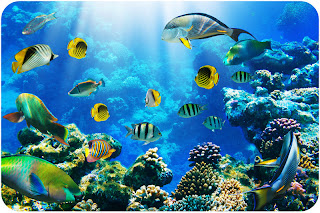Freshwater Regions:
 Freshwater is said to be low in salt content. Examples consist of lakes, ponds, swamps, wetlands, and rivers. The accumulation of the ice melts formed during the ice age lead to the creation of our manmade lakes seen today. Lakes and ponds are separated by different zones defined by their distance from the shore. The littoral zone is closest to the shore. The environment is shallow and warm which allows for it to host a widespread variety of species such as invertebrates, crustaceans, and amphibians. These creatures are food for predators such as reptiles or birds. The limnetic zone is the open water near the surface of a lake or pond. This is a host to phytoplankton and zooplankton which is another important factor in the food chain. Bass and lake trout feed off of these creatures. An estuary is where the freshwater meets the saltwater. This is to be considered a "trade center" to the world's aquatic biome to due the unique and different species found in it.
Freshwater is said to be low in salt content. Examples consist of lakes, ponds, swamps, wetlands, and rivers. The accumulation of the ice melts formed during the ice age lead to the creation of our manmade lakes seen today. Lakes and ponds are separated by different zones defined by their distance from the shore. The littoral zone is closest to the shore. The environment is shallow and warm which allows for it to host a widespread variety of species such as invertebrates, crustaceans, and amphibians. These creatures are food for predators such as reptiles or birds. The limnetic zone is the open water near the surface of a lake or pond. This is a host to phytoplankton and zooplankton which is another important factor in the food chain. Bass and lake trout feed off of these creatures. An estuary is where the freshwater meets the saltwater. This is to be considered a "trade center" to the world's aquatic biome to due the unique and different species found in it.Marine Regions:

Marine regions are divided by coral reefs, estuaries, and oceans. Oceans are the most diverse and largest ecosystems. Salt water found in oceans evaporates and turns in to rain which falls on the land regions. Algae is responsible for the absorption of carbon dioxide from our atmosphere. The inter-tidal zone connects the land to the ocean. In the shallow warm waters are barriers called coral reefs. It is a living organism consisting of algae and animal tissue. They catch micro-organisms with their tentacles and feed off of photosynthesis. The coral is also a habitat for species such as starfish. the open ocean is known as the pelagic zone where marine mammals and fish live. Underneath is the benthic zone, or the deep sea where silt, sand, and decomposing organisms live. The deep-sea is very cold due to the depth and lack of sunlight. The Abyssal zone is the deepest part of the ocean and is a host to coelacanth, a prehistoric fish that was thought to be extinct. This zone is extremely cold and highly pressurized. The floor of the ocean has vents formed by tectonic plates which release hydrogen sulfide. Hydrogen sulfide and other materials are consumed by bacteria which are consumed by micro-organisms, which are in return, consumed by fish and other organisms and so on.
Life began billions of years ago in the ocean. Species will keep disappearing and appearing without our knowledge due to the power of evolution.
